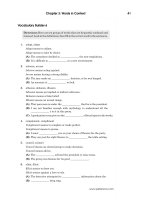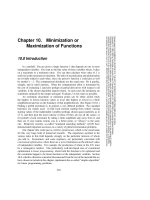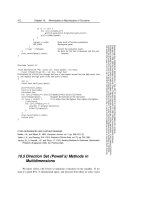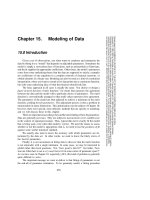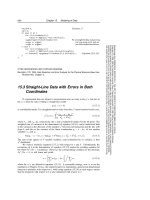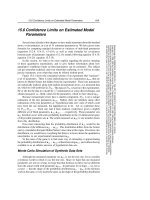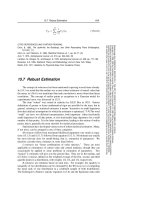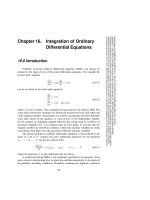Tài liệu Integration of Functions part 6 pptx
Bạn đang xem bản rút gọn của tài liệu. Xem và tải ngay bản đầy đủ của tài liệu tại đây (268.04 KB, 15 trang )
4.5 Gaussian Quadratures and Orthogonal Polynomials
147
Sample page from NUMERICAL RECIPES IN C: THE ART OF SCIENTIFIC COMPUTING (ISBN 0-521-43108-5)
Copyright (C) 1988-1992 by Cambridge University Press.Programs Copyright (C) 1988-1992 by Numerical Recipes Software.
Permission is granted for internet users to make one paper copy for their own personal use. Further reproduction, or any copying of machine-
readable files (including this one) to any servercomputer, is strictly prohibited. To order Numerical Recipes books,diskettes, or CDROMs
visit website or call 1-800-872-7423 (North America only),or send email to (outside North America).
Dahlquist, G., and Bjorck, A. 1974,
Numerical Methods
(Englewood Cliffs, NJ: Prentice-Hall),
§
7.4.3, p. 294.
Stoer, J., and Bulirsch, R. 1980,
Introduction to Numerical Analysis
(New York: Springer-Verlag),
§
3.7, p. 152.
4.5 Gaussian Quadratures and Orthogonal
Polynomials
In the formulas of §4.1, the integral of a function was approximated by the sum
of its functional values at a set of equally spaced points, multiplied by certain aptly
chosen weighting coefficients. We saw that as we allowed ourselves more freedom
in choosing the coefficients, we could achieve integration formulas of higher and
higher order. The idea of Gaussian quadratures is to give ourselves the freedom to
choose not only the weighting coefficients, but also the location of the abscissas at
which the function is to be evaluated: They will no longer be equally spaced. Thus,
we will have twice the number of degrees of freedom at our disposal; it will turn out
that we can achieve Gaussian quadrature formulas whose order is, essentially, twice
that of the Newton-Cotes formula with the same number of function evaluations.
Does this sound too good to be true? Well, in a sense it is. The catch is a
familiar one, which cannot be overemphasized: High order is not the same as high
accuracy. High order translates to high accuracy only when the integrand is very
smooth, in the sense of being “well-approximated by a polynomial.”
There is, however, one additional feature of Gaussian quadrature formulas that
adds to their usefulness: We can arrange the choice of weights and abscissas to make
the integral exact for a class of integrands “polynomials times some known function
W (x)” rather than for the usual class of integrands “polynomials.” The function
W (x) can then be chosen to remove integrable singularitiesfrom the desired integral.
Given W (x), in other words, and given an integer N, we can find a set of weights
w
j
and abscissas x
j
such that the approximation
b
a
W (x)f(x)dx ≈
N
j=1
w
j
f(x
j
)(4.5.1)
is exact if f(x) is a polynomial. For example, to do the integral
1
−1
exp(− cos
2
x)
√
1 − x
2
dx (4.5.2)
(not a very natural looking integral, it must be admitted), we might well be interested
in a Gaussian quadrature formula based on the choice
W (x)=
1
√
1−x
2
(4.5.3)
in theinterval (−1, 1). (This particularchoiceis calledGauss-Chebyshevintegration,
for reasons that will become clear shortly.)
148
Chapter 4. Integration of Functions
Sample page from NUMERICAL RECIPES IN C: THE ART OF SCIENTIFIC COMPUTING (ISBN 0-521-43108-5)
Copyright (C) 1988-1992 by Cambridge University Press.Programs Copyright (C) 1988-1992 by Numerical Recipes Software.
Permission is granted for internet users to make one paper copy for their own personal use. Further reproduction, or any copying of machine-
readable files (including this one) to any servercomputer, is strictly prohibited. To order Numerical Recipes books,diskettes, or CDROMs
visit website or call 1-800-872-7423 (North America only),or send email to (outside North America).
Notice that the integration formula (4.5.1) can also be written with the weight
function W (x) not overtly visible: Define g(x) ≡ W (x)f(x) and v
j
≡ w
j
/W (x
j
).
Then (4.5.1) becomes
b
a
g(x)dx ≈
N
j=1
v
j
g(x
j
)(4.5.4)
Where did the function W (x) go? It is lurking there, ready to give high-order
accuracy to integrands of the form polynomialstimes W (x), and ready to deny high-
order accuracy to integrands that are otherwise perfectly smooth and well-behaved.
When you find tabulations of the weights and abscissas for a given W (x), you have
to determine carefully whether they are to be used with a formula in the form of
(4.5.1), or like (4.5.4).
Here is an example of a quadrature routine that contains the tabulated abscissas
and weights for the case W (x)=1and N =10. Since the weights and abscissas
are, in this case, symmetric around the midpoint of the range of integration, there
are actually only five distinct values of each:
float qgaus(float (*func)(float), float a, float b)
Returns the integral of the function
func
between
a
and
b
, by ten-point Gauss-Legendre inte-
gration: the function is evaluated exactly ten times at interior points in the range of integration.
{
int j;
float xr,xm,dx,s;
static float x[]={0.0,0.1488743389,0.4333953941, The abscissas and weights.
First value of each array
not used.
0.6794095682,0.8650633666,0.9739065285};
static float w[]={0.0,0.2955242247,0.2692667193,
0.2190863625,0.1494513491,0.0666713443};
xm=0.5*(b+a);
xr=0.5*(b-a);
s=0; Will be twice the average value of the function, since the
ten weights (five numbers above each used twice)
sum to 2.
for (j=1;j<=5;j++) {
dx=xr*x[j];
s += w[j]*((*func)(xm+dx)+(*func)(xm-dx));
}
return s *= xr; Scale the answer to the range of integration.
}
The above routine illustrates that one can use Gaussian quadratures without
necessarily understandingthe theory behindthem: One just locates tabulatedweights
and abscissas in a book (e.g.,
[1]
or
[2]
). However, the theory is very pretty, and it
will come in handy if you ever need to construct your own tabulation of weights and
abscissas for an unusual choice of W (x). We will therefore give, without any proofs,
some useful results that will enable you to do this. Several of the results assume that
W (x) does not change sign inside (a, b), which is usually the case in practice.
The theory behind Gaussian quadratures goes back to Gauss in 1814, who
used continued fractions to develop the subject. In 1826 Jacobi rederived Gauss’s
results by means of orthogonal polynomials. The systematic treatment of arbitrary
weight functions W (x) using orthogonalpolynomials is largely due to Christoffelin
1877. To introduce these orthogonal polynomials, let us fix the interval of interest
to be (a, b). We can define the “scalar product of two functions f and g over a
4.5 Gaussian Quadratures and Orthogonal Polynomials
149
Sample page from NUMERICAL RECIPES IN C: THE ART OF SCIENTIFIC COMPUTING (ISBN 0-521-43108-5)
Copyright (C) 1988-1992 by Cambridge University Press.Programs Copyright (C) 1988-1992 by Numerical Recipes Software.
Permission is granted for internet users to make one paper copy for their own personal use. Further reproduction, or any copying of machine-
readable files (including this one) to any servercomputer, is strictly prohibited. To order Numerical Recipes books,diskettes, or CDROMs
visit website or call 1-800-872-7423 (North America only),or send email to (outside North America).
weight function W ”as
f|g≡
b
a
W(x)f(x)g(x)dx (4.5.5)
The scalar product is a number, not a function of x. Two functions are said to be
orthogonal if their scalar product is zero. A function is said to be normalized if its
scalar product with itself is unity. A set of functions that are all mutually orthogonal
and also all individually normalized is called an orthonormal set.
We can find a set of polynomials (i) that includes exactly one polynomial of
order j, called p
j
(x), for each j =0,1,2,..., and (ii) all of which are mutually
orthogonal over the specified weight function W (x). A constructive procedure for
finding such a set is the recurrence relation
p
−1
(x) ≡ 0
p
0
(x) ≡ 1
p
j+1
(x)=(x−a
j
)p
j
(x)−b
j
p
j−1
(x) j=0,1,2,...
(4.5.6)
where
a
j
=
xp
j
|p
j
p
j
|p
j
j =0,1,...
b
j
=
p
j
|p
j
p
j−1
|p
j−1
j =1,2,...
(4.5.7)
The coefficient b
0
is arbitrary; we can take it to be zero.
The polynomials defined by (4.5.6) are monic, i.e., the coefficient of their
leading term [x
j
for p
j
(x)] is unity. If we divide each p
j
(x) by the constant
[p
j
|p
j
]
1/2
we can render the set of polynomials orthonormal. One also encounters
orthogonal polynomials with various other normalizations. You can convert from
a given normalization to monic polynomials if you know that the coefficient of
x
j
in p
j
is λ
j
, say; then the monic polynomials are obtained by dividing each p
j
by λ
j
. Note that the coefficients in the recurrence relation (4.5.6) depend on the
adopted normalization.
The polynomial p
j
(x) can be shown to have exactly j distinct roots in the
interval (a, b). Moreover, it can be shown that the roots of p
j
(x) “interleave” the
j − 1 roots of p
j−1
(x), i.e., there is exactly one root of the former in between each
two adjacent roots of the latter. This fact comes in handy if you need to find all the
roots: You can start with the one root of p
1
(x) and then, in turn, bracket the roots
of each higher j, pinning them down at each stage more precisely by Newton’s rule
or some other root-finding scheme (see Chapter 9).
Why would you ever want to find all the roots of an orthogonal polynomial
p
j
(x)? Because the abscissas of the N-point Gaussian quadrature formulas (4.5.1)
and (4.5.4) with weightingfunction W (x) in the interval (a, b) are precisely the roots
of the orthogonal polynomial p
N
(x) for the same interval and weighting function.
This is the fundamental theorem of Gaussian quadratures, and lets you find the
abscissas for any particular case.
150
Chapter 4. Integration of Functions
Sample page from NUMERICAL RECIPES IN C: THE ART OF SCIENTIFIC COMPUTING (ISBN 0-521-43108-5)
Copyright (C) 1988-1992 by Cambridge University Press.Programs Copyright (C) 1988-1992 by Numerical Recipes Software.
Permission is granted for internet users to make one paper copy for their own personal use. Further reproduction, or any copying of machine-
readable files (including this one) to any servercomputer, is strictly prohibited. To order Numerical Recipes books,diskettes, or CDROMs
visit website or call 1-800-872-7423 (North America only),or send email to (outside North America).
Once you know the abscissas x
1
,...,x
N
, you need to find the weights w
j
,
j =1,...,N. One way to do this (not the most efficient) is to solve the set of
linear equations
p
0
(x
1
) ... p
0
(x
N
)
p
1
(x
1
) ... p
1
(x
N
)
.
.
.
.
.
.
p
N−1
(x
1
) ... p
N−1
(x
N
)
w
1
w
2
.
.
.
w
N
=
b
a
W(x)p
0
(x)dx
0
.
.
.
0
(4.5.8)
Equation (4.5.8) simply solves for those weightssuch that the quadrature (4.5.1)
gives the correct answer for the integral of the first N orthogonal polynomials. Note
that the zeros on the right-hand side of (4.5.8) appear because p
1
(x),...,p
N−1
(x)
are all orthogonal to p
0
(x), which is a constant. It can be shown that, with those
weights, the integral of the next N − 1 polynomials is also exact, so that the
quadrature is exact for all polynomials of degree 2N − 1 or less. Another way to
evaluate the weights (though one whose proof is beyond our scope) is by the formula
w
j
=
p
N −1
|p
N −1
p
N −1
(x
j
)p
N
(x
j
)
(4.5.9)
where p
N
(x
j
) is the derivative of the orthogonal polynomial at its zero x
j
.
Thecomputationof Gaussian quadrature rulesthus involvestwo distinct phases:
(i) the generation of the orthogonal polynomials p
0
,...,p
N
, i.e., the computation of
the coefficients a
j
, b
j
in (4.5.6); (ii) the determination of the zeros of p
N
(x),and
the computation of the associated weights. For the case of the “classical” orthogonal
polynomials, the coefficients a
j
and b
j
are explicitly known (equations 4.5.10 –
4.5.14 below) and phase (i) can be omitted. However, if you are confronted with a
“nonclassical” weight function W (x), and you don’t know the coefficients a
j
and
b
j
, the construction of the associated set of orthogonal polynomials is not trivial.
We discuss it at the end of this section.
Computation of the Abscissas and Weights
This task can range from easy to difficult, depending on how much you already
know about your weight function and its associated polynomials. In the case of
classical, well-studied, orthogonal polynomials, practically everything is known,
includinggood approximationsfor theirzeros. These can be used as startingguesses,
enabling Newton’s method (to be discussed in §9.4) to converge very rapidly.
Newton’s method requires the derivative p
N
(x), which is evaluated by standard
relations in terms of p
N
and p
N −1
. The weights are then conveniently evaluated by
equation (4.5.9). For the following named cases, this direct root-finding is faster,
by a factor of 3 to 5, than any other method.
Here are the weight functions, intervals, and recurrence relations that generate
the most commonly used orthogonal polynomials and their corresponding Gaussian
quadrature formulas.
4.5 Gaussian Quadratures and Orthogonal Polynomials
151
Sample page from NUMERICAL RECIPES IN C: THE ART OF SCIENTIFIC COMPUTING (ISBN 0-521-43108-5)
Copyright (C) 1988-1992 by Cambridge University Press.Programs Copyright (C) 1988-1992 by Numerical Recipes Software.
Permission is granted for internet users to make one paper copy for their own personal use. Further reproduction, or any copying of machine-
readable files (including this one) to any servercomputer, is strictly prohibited. To order Numerical Recipes books,diskettes, or CDROMs
visit website or call 1-800-872-7423 (North America only),or send email to (outside North America).
Gauss-Legendre:
W (x)=1 −1<x<1
(j+1)P
j+1
=(2j+1)xP
j
− jP
j−1
(4.5.10)
Gauss-Chebyshev:
W (x)=(1−x
2
)
−1/2
−1<x<1
T
j+1
=2xT
j
− T
j−1
(4.5.11)
Gauss-Laguerre:
W (x)=x
α
e
−x
0<x<∞
(j+1)L
α
j+1
=(−x+2j+α+1)L
α
j
−(j+α)L
α
j−1
(4.5.12)
Gauss-Hermite:
W (x)=e
−x
2
−∞<x<∞
H
j+1
=2xH
j
− 2jH
j−1
(4.5.13)
Gauss-Jacobi:
W (x)=(1−x)
α
(1 + x)
β
− 1 <x<1
c
j
P
(α,β)
j+1
=(d
j
+e
j
x)P
(α,β)
j
− f
j
P
(α,β)
j−1
(4.5.14)
where the coefficients c
j
,d
j
,e
j
,andf
j
are given by
c
j
=2(j+1)(j+α+β+ 1)(2j + α + β)
d
j
=(2j+α+β+1)(α
2
−β
2
)
e
j
=(2j+α+β)(2j + α + β + 1)(2j + α + β +2)
f
j
=2(j+α)(j + β)(2j + α + β +2)
(4.5.15)
We now give individual routines that calculate the abscissas and weights for
these cases. First comes the most common set of abscissas and weights, those of
Gauss-Legendre. The routine, due to G.B. Rybicki, uses equation (4.5.9) in the
special form for the Gauss-Legendre case,
w
j
=
2
(1 − x
2
j
)[P
N
(x
j
)]
2
(4.5.16)
Theroutine also scales therangeof integration from (x
1
,x
2
)to (−1, 1), and provides
abscissas x
j
and weights w
j
for the Gaussian formula
x
2
x
1
f(x)dx =
N
j=1
w
j
f(x
j
)(4.5.17)
152
Chapter 4. Integration of Functions
Sample page from NUMERICAL RECIPES IN C: THE ART OF SCIENTIFIC COMPUTING (ISBN 0-521-43108-5)
Copyright (C) 1988-1992 by Cambridge University Press.Programs Copyright (C) 1988-1992 by Numerical Recipes Software.
Permission is granted for internet users to make one paper copy for their own personal use. Further reproduction, or any copying of machine-
readable files (including this one) to any servercomputer, is strictly prohibited. To order Numerical Recipes books,diskettes, or CDROMs
visit website or call 1-800-872-7423 (North America only),or send email to (outside North America).
#include <math.h>
#define EPS 3.0e-11 EPS is the relative precision.
void gauleg(float x1, float x2, float x[], float w[], int n)
Given the lower and upper limits of integration
x1
and
x2
,andgiven
n
, this routine returns
arrays
x[1..n]
and
w[1..n]
of length
n
, containing the abscissas and weights of the Gauss-
Legendre
n
-point quadrature formula.
{
int m,j,i;
double z1,z,xm,xl,pp,p3,p2,p1; High precision is a good idea for this rou-
tine.
m=(n+1)/2; The roots are symmetric in the interval, so
weonlyhavetofindhalfofthem.xm=0.5*(x2+x1);
xl=0.5*(x2-x1);
for (i=1;i<=m;i++) { Loop over the desired roots.
z=cos(3.141592654*(i-0.25)/(n+0.5));
Starting with the above approximation to the ith root, we enter the main loop of
refinement by Newton’s method.
do {
p1=1.0;
p2=0.0;
for (j=1;j<=n;j++) { Loop up the recurrence relation to get the
Legendre polynomial evaluated at z.p3=p2;
p2=p1;
p1=((2.0*j-1.0)*z*p2-(j-1.0)*p3)/j;
}
p1 is now the desired Legendre polynomial. We next compute pp, its derivative,
by a standard relation involving also p2, the polynomial of one lower order.
pp=n*(z*p1-p2)/(z*z-1.0);
z1=z;
z=z1-p1/pp; Newton’s method.
} while (fabs(z-z1) > EPS);
x[i]=xm-xl*z; Scale the root to the desired interval,
x[n+1-i]=xm+xl*z; and put in its symmetric counterpart.
w[i]=2.0*xl/((1.0-z*z)*pp*pp); Compute the weight
w[n+1-i]=w[i]; and its symmetric counterpart.
}
}
Next we give three routines that use initial approximations for the roots given
by Stroud and Secrest
[2]
. The first is for Gauss-Laguerre abscissas and weights, to
be used with the integration formula
∞
0
x
α
e
−x
f(x)dx =
N
j=1
w
j
f(x
j
)(4.5.18)
#include <math.h>
#define EPS 3.0e-14 Increase EPS if you don’t have this preci-
sion.#define MAXIT 10
void gaulag(float x[], float w[], int n, float alf)
Given
alf
, the parameter α of the Laguerre polynomials, this routine returns arrays
x[1..n]
and
w[1..n]
containing the abscissas and weights of the
n
-point Gauss-Laguerre quadrature
formula. The smallest abscissa is returned in
x[1]
, the largest in
x[n]
.
{
float gammln(float xx);
void nrerror(char error_text[]);
int i,its,j;
float ai;
